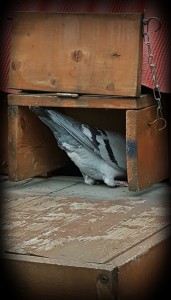There are hundreds of theories in pigeon racing on how to determine a good racing pigeon. To name a few, there is: eye sign, throat sign, general feather color, wing length, muscle density, steps between primary flights, keel depth, skin color, muscle vibration, birth order, overall handling, level of nervousness, ancestors/pedigrees, perch order, muscle elasticity, etc. To a new pigeon racing fancier, this may and should come as a difficult thing to grasp. Like most theories, there may be a level of truth to them, but these truths are some times not evident in extraordinary pigeons . . . so should we take them with a grain of salt? No, there is a lesson to be learned. The biggest lesson to be learned is to PAY ATTENTION to how and why your birds act the way they do. Behind every good racing pigeon there is motivation. Motivation, however, is most notable through the theory of tail sign. What a fancier learns through each individual pigeons tail sign is the best way to determine which races are most fitting for a particular bird. Why do some of the pigeon greats know to wager large sums of money on a particular bird for a particular race? The answer is the tail sign of that bird and its ancestors. Tail sign is somewhat hereditary, but as with all non-phenotypic pigeon genetics, there are many exceptions to this rule. The living tail sign of a particular racing pigeon rarely lies, however, and is much more accurate then all of the other theories combined. Fanciers often only look at numbers or pedigrees, and forget the motivation aspect and then wonder why the theory of tail sign did not hold true. So what is exactly is tail sign? It’s not color or length of the tail, nor whether the tail is faced up or down. Simply put, it is the first tail that you see go through the trap on race day.
Wed
01 Jul

